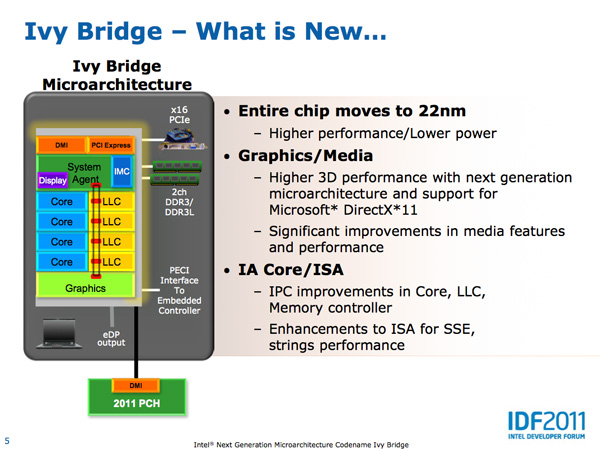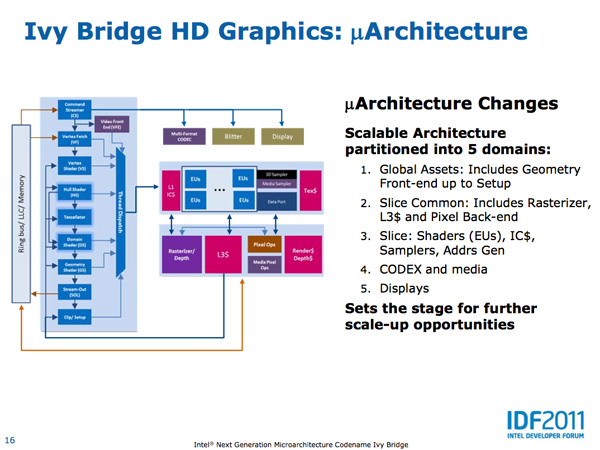The Ivy Bridge Preview: Core i7 3770K Tested
by Anand Lal Shimpi on March 6, 2012 8:16 PM EST- Posted in
- CPUs
- Intel
- Core i7
- Ivy Bridge
Ivy Bridge Architecture Recap
At IDF Intel disclosed much of Ivy's CPU architecture, but below is a quick summary:
- 4-wide front end with µOp cache from Sandy Bridge
- OoO execution engine from Sandy Bridge
- Data structures previously statically shared between threads can now be dynamically shared (e.g. DSB queue), improves single threaded performance
- FP/integer divider delivers 2x throughput compared to Sandy Bridge
- MOV instructions no longer occupy an execution port, potential for improved ILP when MOVs are present
- Power gated DDR3 interface
- DDR3L support
- Max supported DDR3 frequency is now 2800MHz (up from 2133MHz), memory speed can be moved in 200MHz increments
- Lower system agent voltage options, lower voltages at intermediate turbo frequencies, power aware interrupt routing
- Power efficiency improvements related to 22nm
- Configurable TDP
I've highlighted the three big items from a CPU performance standpoint. Much of the gains you'll see will come from those areas coupled with more aggressive turbo frequencies.


On the GPU, the improvements are more significant. Some of the major changes are below:
- DirectX 11 Support
- More execution units (16 vs 12) for GT2 graphics (Intel HD 4000)
- 2x MADs per clock
- EUs can now co-issue more operations
- GPU specific on-die L3 cache
- Faster QuickSync performance
- Lower power consumption due to 22nm






















195 Comments
View All Comments
krumme - Wednesday, March 7, 2012 - link
Well the dilemma for Anand is apparent. If he stops writing those previews that is nice to Intel, someone else will get the oportunity and all the info. He can write two bad previews and the info and early chips just stops comming. Intel and Anand have a business to run, and there is a reason Intel gives Anand the chips (indirectly).He have a "deal" with Intel, the same way we have a deal with Anand when we read the review. We get the info - bended/biased - and then we can think ourselves. I think its a fair deal :) - we get a lot of good info from this preview. The uninformed gets raped, but its alway like that. Someone have to pay for the show.
chemist1 - Wednesday, March 7, 2012 - link
The Macbook Pro, for instance, has a discrete GPU, yet can switch to the chip-based GPU to save power when on battery. So having a better chip-based GPU makes sense in this context.Sabresiberian - Wednesday, March 7, 2012 - link
I'd like to see the discreet graphics card industry make the kind of progress, relatively speaking, Intel has made in the last 2 years.Ivy Bridge is a ways from competing with a high-end discreet solution, but if the relative rates in progress don't change, Intel will catch up soon.
sixtyfivedays - Wednesday, March 7, 2012 - link
I use the iGPU on my build for my second monitor and it is quite nice.I can watch HD videos on it and it doesn't take away from my dedicated GPU at all.
mlkmade - Thursday, March 8, 2012 - link
Is that even possible? Special hack or software?When you install a discrete graphics card, the integrated gpu gets disabled.
Would love to know how you accomplished this..Is it a desktop or laptop?
mathew7 - Thursday, March 8, 2012 - link
"When you install a discrete graphics card, the integrated gpu gets disabled."It was exclusive in northbridge-IGP units (Core2Duo/Quad and older). With Core-i, it's by default disabled but can be enabled through BIOS (of course if you don't have a P5x/6x chipset).
AnnonymousCoward - Wednesday, March 7, 2012 - link
1. How much faster is Ivy Bridge at single thread versus my Conroe@3GHz?2. How much faster is my GTX560Ti than HD4000?
dr/owned - Thursday, March 8, 2012 - link
1) Your 65 nm cpu would get the shit blow out of it by IB at the same clock speed in single threaded applications. Assuming 15% improvements in each of the tick-tocks since Conroe, a 1.8 Ghz IB would probably be about the same as a 3 Ghz Conroe.2) Discrete graphics vs. integrated graphics. Intel isn't trying to compete here so it's a stupid comparison.
AnnonymousCoward - Friday, March 9, 2012 - link
1. Your "get the shit blown out" is worthless. All I'm looking for is a number, and your effective answer is +67%.2. It's not a stupid comparison, because:
a) I'm interested.
b) HD4000 is designed for games.
c) They benchmarked with modern games.
d) Games are designed around people's performance.
AnnonymousCoward - Friday, March 9, 2012 - link
1. Another website shows the i7 3770K scored 2643 on the Fritz Chess Benchmark with 1 processor. My machine does 2093. That's only 26% different.2. I very roughly estimate the GTX560Ti might be 5-6x faster than the HD4000.
It'd be useful to see a real comparison of these though.